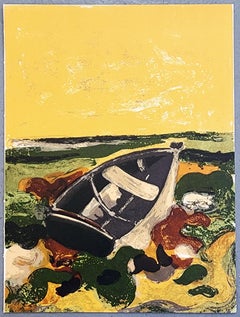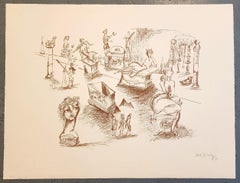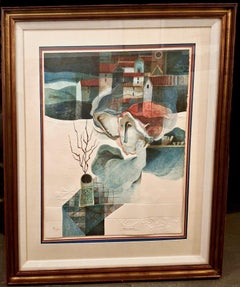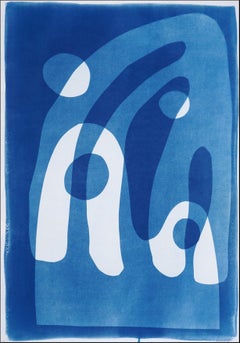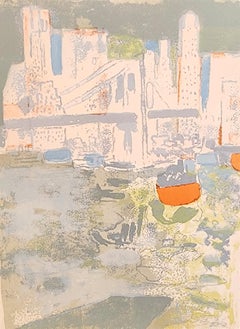Vellum Landscape Prints
to
4
3
1
Overall Width
to
Overall Height
to
4
1
1
1
4
4
3
1
2
2
2
1
1
1
1
1
1
1
1
1
1
156
2,572
1,187
295
289
4
Style: Modern
Medium: Vellum
La Barque Echouee (Mourlot, Paris)
By Andre Minaux
Located in Kansas City, MO
Andre Minaux
La Barque Echouee
1964
Original Color Lithograph on Velin d'Arches
Size: 10x7.375in
Edition: 2,000
Annotated verso
Unsigned as issued
Publisher: Mourlot, Paris
Printer: ...
Category
1960s Modern Vellum Landscape Prints
Materials
Vellum, Lithograph
$98 Sale Price
60% Off
Saint-Jean-de-Luz : La Plage Noir (Mourlot, Paris)
Located in Kansas City, MO
Maurice Brianchon
Saint-Jean-de-Luz : La Plage
1964
Original Color Lithograph on Velin d'Arches
Size: 10x7.375in
Edition: 2,000
Annotated verso
Unsigned as issued
Publisher: Mourlot,...
Category
1960s Modern Vellum Landscape Prints
Materials
Vellum, Lithograph
$98 Sale Price
60% Off
La Seine a Paris (75% OFF LIST PRICE FOR A LIMITED TIME, FRAMING OPTIONS AVAIL)
Located in Kansas City, MO
Richard Florsheim
La Seine a Paris
1964
Original Color Lithograph on Velin d'Arches
Size: 10x7.375in
Edition: 2,000
Annotated verso
Unsigned as issued
Publisher: Mourlot, Paris
Print...
Category
1960s Modern Vellum Landscape Prints
Materials
Vellum, Lithograph
Romantische Reisende III
Located in Kansas City, MO
Bele Bachem
Romantische Reisende III
Lithograph on Velum
Year: 1967
Size: 19.25x25.5in
Signed, dated and inscribed by hand
Edition: 150
Publisher: Edition ...
Category
1960s Modern Vellum Landscape Prints
Materials
Vellum, Lithograph
$366 Sale Price
28% Off
Related Items
“Winter” from the “Four Seasons Suite” Series
Located in San Francisco, CA
This embossed, numbered and signed lithograph, part of the “Four Seasons Suite,” is by Alvar Suñol Muñoz-Ramos (b. 1935), a renowned Spanish ar...
Category
1970s Modern Vellum Landscape Prints
Materials
Paper, Lithograph
$1,350
H 37.25 in W 30.5 in D 2 in
Rain Over Mountain, Modern Art in Blue Tones, Landscape, Cyanotype Monotype 2024
By Kind of Cyan
Located in Barcelona, ES
This is an exclusive handprinted unique cyanotype that takes its inspiration from the mid-century modern shapes.
It's made by layering paper cutouts and different exposures using uv-...
Category
2010s Modern Vellum Landscape Prints
Materials
Watercolor, Lithograph, Monotype, Paper
Royal Hotel - New Orleans 1920s Depression Art Lithograph in Ink on Paper
Located in Soquel, CA
Royal Hotel - New Orleans 1920s Depression Art Lithograph in Ink on Paper
Dramatic street scene with a man wearing a trench coat and hat by Robert J We...
Category
Late 20th Century American Modern Vellum Landscape Prints
Materials
Paper, Lithograph
$780 Sale Price
20% Off
H 20 in W 16 in D 0.25 in
Ten of views of Manhattan (10).
Located in Middletown, NY
The Society of Iconophiles (New York, 1894–1936), 1898. Each a lithograph printed on grayish-green, or white wove paper each sheet 10 3/4 x 7 1/2 inches (274 x 190 mm), each with ful...
Category
Early 20th Century American Modern Vellum Landscape Prints
Materials
Handmade Paper, Lithograph
Arnold Ronnebeck Lithograph of Gregory Point, Colorado, 1930s Modernist Print
Located in Denver, CO
This original 1930s lithograph by renowned modernist artist Arnold Ronnebeck (1885–1947) captures a historic home at Gregory Point, near Central City, Colorado. Part of a limited edi...
Category
1930s American Modern Vellum Landscape Prints
Materials
Paper, Lithograph
$2,650
H 23.25 in W 18.5 in D 1.5 in
Frank Lloyd Wright's Ennis House, Los Angeles - Lithograph on Paper
Located in Soquel, CA
Frank Lloyd Wright's Ennis House, Los Angeles - Lithograph on Paper
Clean, modern lithograph of the Ennis House in Los Angeles by Frances Myers (American, 1936-2014). The Ennis House sits at the top of a small hill, cutting a strong line against a soft peach-colored sky. Wright's strong sense of balance is highlighted in this composition, with patterns and lines guiding the viewers eye in various directions around the piece.
Numbered, titled, signed and dated along the bottom edge:
7/50 Ennis House - Los Angeles Frances Myers 1980
Paper size: 29.5"H x 38"W
Print size: 24"H x 32"W
Shipped rolled in a tube.
Myers was born on April 16, 1936, in Racine, Wisconsin. She began her studies at the San Francisco Art Institute, but soon transferred to the University of Wisconsin–Madison where she earned a BS in 1962, and an MFA in 1965.
Myers employed a variety of printmaking techniques in her career including "relief, photo-etching, and mixed media processes."
Myers is best known for her prints depicting various buildings. She once said, “I don’t want to invent a building, I want to bring new life to a building.” Growing up in Racine, Myers was exposed to many of Frank Lloyd Wright's architectural works, and she paid tribute to this in her 1980 work The Frank Lloyd Wright Print...
Category
1980s Modern Vellum Landscape Prints
Materials
Paper, Ink, Lithograph
$880 Sale Price
20% Off
H 29.5 in W 38 in D 0.01 in
At the Seaside - Lithograph by Luigi Bartolini - 1962
Located in Roma, IT
Figure al mare (At the Seaside) is a modern artwork realized by the Italian artist Luigi Bartolini in 1962.
Original lithograph on ivory-colored cardboard.
Passepartout included.
...
Category
1960s Modern Vellum Landscape Prints
Materials
Paper, Lithograph
$417
H 28.75 in W 20.87 in D 0.04 in
Before the Trotting Race - Original Lithograph Handsigned Numbered
By Yves Brayer
Located in Paris, IDF
Yves Brayer (1907-1990)
Before the Trotting Race
Original lithograph, c.1973
Handsigned in pencil by the artist
Numbered /250 copies
Size 50 x 65 cm, on Arches Vellum
Information: ...
Category
1970s Vellum Landscape Prints
Materials
Vellum, Lithograph
$357
H 19.69 in W 25.6 in
Ancient View of the Ruins of Palmira - Original Lithograph - Mid-19th Century
Located in Roma, IT
Ancient Ruins of Palmira is an original modern artwork realized in the mid-19th Century.
Original B/W Lithograph on Ivory Paper.
Inscripted on the lower margin in Capital Letters...
Category
Mid-19th Century Modern Vellum Landscape Prints
Materials
Paper, Lithograph
$286
H 3.55 in W 5.91 in D 0.04 in
Épinal - Original Lithograph - 19th Century
Located in Roma, IT
Épinal- France Pittoresque is an original lithograph realized by an Anonymous artist of the 19th Century.
Printed in series of "France Pittoresque" at the top center.
Titled in Fra...
Category
19th Century Modern Vellum Landscape Prints
Materials
Paper, Lithograph
Acropolis Americana - Lincoln Center, New York 1975
Located in Middletown, NY
Zinc lithograph on cream wove paper, 12 3/4 x 10 inches (272 x 253 mm), full margins. Signed and titled in pencil, lower margin. One work from the series titled "Salute to New York,"...
Category
20th Century American Modern Vellum Landscape Prints
Materials
Handmade Paper, Lithograph
Venice Cityscape - Lithograph - 1960s
Located in Roma, IT
Venice Cityscape is an original lithograph on paper realized in 1960 ca. by an anonymous artist of the 20th Century.
Hand-signed on the lower right in pencil, illegible.
Numbered ...
Category
1960s Modern Vellum Landscape Prints
Materials
Paper, Lithograph
Previously Available Items
Le Port de New York (Mourlot, Paris)
Located in Kansas City, MO
Paul Guiramand
Le Port de New York
1964
Original Color Lithograph on Velin d'Arches
Size: 10x7.375in
Edition: 2,000
Annotated verso
Unsigned as issued
Publisher: Mourlot, Paris
Print...
Category
1960s Modern Vellum Landscape Prints
Materials
Vellum, Lithograph
Vellum landscape prints for sale on 1stDibs.
Find a wide variety of authentic Vellum landscape prints available on 1stDibs. While artists have worked in this medium across a range of time periods, art made with this material during the 20th Century is especially popular. There are many well-known artists whose body of work includes ceramic sculptures. Popular artists on 1stDibs associated with pieces like this include Yves Brayer, Maurice Brianchon, Richard Florsheim, and Paul Guiramand. Frequently made by artists working in the Modern, all of these pieces for sale are unique and many will draw the attention of guests in your home. Not every interior allows for large Vellum landscape prints, so small editions measuring 0.01 inches across are also available
